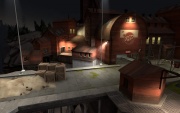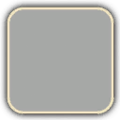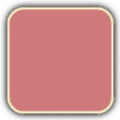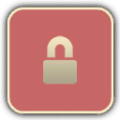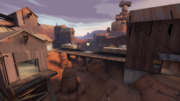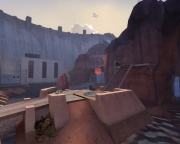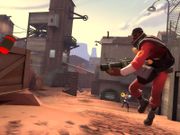Cartes
Au début, Team Fortress 2 a été lancé avec six cartes (Dustbowl, Granary, Gravel Pit, Well, 2Fort, and Hydro) avec trois modes de jeux (CP, CTF, TC). Actuellement, il y a 35 cartes officielles avec sept modes de jeux différants (CP, CTF, TC, PL, ARENA, PLR, KOTH). Les cartes de la communautée (identifié en italique) sont des cartes développées par les joueurs et officiellement choisies par Valve a cause de leur bonne qualitée. Voir Custom Maps pour des informations sur les cartes non-officielles.
Sommaire
Capture de drapeau (CTF)
| « | Wave goodbye to ya secret crap, dumbass!
Cliquer pour écouter
— The Scout
|
» |
Le Capture the Flag, (Capture de drapeau en français) est présent sur les cartes qui portent le préfixe ctf_ . Dans ce mode de jeu, RED et BLU possèdent tout deux une Intelligence briefcase (le drapeau), placé loin dans leurs camps respectifs. Les cartes CTF sont habituellement élaborées de manière symètrique, dans un souci d'égalité entre les deux équipes. Les joueurs doivent essayer d'infiltrer la base ennemie et capturer leur documents un certain nombre de fois, avant que leurs document n'aient eux-même été capturés le même nombre de fois (la limite par défaut est 3). Une partie de l'équipe doit donc rester dans la base, pour protéger ses propres documents des incursions ennemies.
Pour capturer les documents de l'ennemi, un joueur doit d'abord entrer dans la 'zone de capture' de l'équipe adverse (indiquée par des lignes jaunes et noires), ensuite, pendant qu'il porte les documents sur son dos, il doit les ramener dans la zone de capture de son équipe, dans sa salle des documents. Après chaque capture réussie, l'équipe est récompensée par 10 secondes de tir critiques.
Si le porteur des documents est tué, ou si les documents sont posés par terre de manière intentionnelle, la Mallette restera stationnaire pendant 60 secondes - un compteur au-dessus du renseignement montrera combien de temps il reste avant qu'elle ne retourne dans sa salle des documents. Durant ce temps, les documents peuvent être recapturés par les "voleurs" en marchant dessus. A chaque fois que la Mallette retombe à terre, le compteur revient à 60 secondes. Les "protecteurs" ne peuvent ni ramasser leurs propres documents, ni diminuer le temps du compteur de la Mallette. Les documents ne peuvent pas être ramassés par un joueur invulnérable (par Übercharge, ou sous l'effet du Bonk). Tout joueur porteur des documents ne peut devenir invulnérable.
Si un joueur portant les documents meurt dans une partie inaccessible de la carte (ex. tomber dans la fosse de Double Cross), les documents sont immédiatement rapportés à leur place, dans la salle des documents.
Si aucune des équipes n'atteint la limite de capture avant la fin du teamps, la partie vas passer en mode Sudden death (Mort subite).
Il existe des variables du CTF, comme certaines cartes où vous ne pouvez capturer les documents adverses que si vous avez ceux de votre équipe en sécurité dans votre salle des documents
Liste des cartes CTF officielles
Control Point
See also: Control points
| « | This point ain't gonna cap itself! Get over here!
Cliquer pour écouter
— The Engineer
|
» |
Control point maps carry the cp_ prefix and have two main types of gamemode (explained below). The control points are circular platforms with a team-colored light in the center projecting a hologram of the logo of the team currently occupying the point. Control points are typically located on, in or near points of interest.
To capture a point owned by the enemy team, the offensive players must simply stand on the point until the capture meter fills with their team color. The more people of the same team on a point, the faster it will capture, though only to a limited extent. Scouts have double the capture rate of any other class, although a Soldier or Demoman with the Pain Train equiped will also count as two people. No capture progress can be made when players of both teams are on the point. If all capturing players are killed or driven off before the capture is completed, the capture progress will not reset immediately but instead will slowly fade away. Control points cannot be captured or defended by invulnerability buffed players.
There are three statuses for a Control Point:
Standard Control Point
These maps are designed in a symmetrical fashion to avoid giving either team an unfair advantage, similar to the Capture The Flag maps. Both teams start with an equal number of controlled points with the central point in neuteral status. Once a point is captured, the timer resets and the next respective control point is unlocked for capture. The team to capture all the points wins. Traditional Control Point maps will go into Sudden death (or Stalemate) if no team captures all the points before times runs out. Control points close to a team's spawn point are captured more quickly by the enemy team. For example, on Well, a lone Scout can capture the final control point in a single second.
Attack/Defend
These maps are designed asymmetrically, contrary to the standard control point maps. RED begins with all the points in their control and defend against BLU, whose goal is to capture all RED's points. RED wins if it prevents BLU from capturing all points before the timer expires. Points captured by BLU are typically locked and cannot be taken back.
Attack/Defend maps can come in various styles. Some maps such as cp_dustbowl, and cp_egypt require BLU, the attacking team, to go through multiple stages before they can ultimately win the map. If the attacking team fails to win each stage, teams will switch and the defenders will then take turn to be the attackers. Other maps such as cp_gravelpit and cp_junction, allow the attacker to capture two points in no particular order (points A or B) before attacking the final point (point C). cp_steel is an unique Attack/Defend map in that capturing each minor capture point (points A, B ,C and D) will allow better accessibility to the main point (point E), such as allowing more routes into point E or extending bridges to the point so that classes other than the Scout, Soldier or Demoman can capture it.
Territorial Control
Territorial control maps carry the tc_ prefix and are arguably the most complex map type. Each round of a tc_ map plays like a small Traditional Control Point map with one point being controlled by each team. A team wins the round when they control both points. Each round is played between two adjacent territories. The starting territories, and thus the open routes, are randomized. When all points except for one team's home territory has been captured by the other team, the final round plays like an Attack/Defend map and the defending team must prevent their final point from being captured. Once a team's home territory is captured, the opposing team is awarded a point and the map resets.
Payload
| « | Onward, great bomb-cart!
Cliquer pour écouter
— The Heavy
|
» |
Payload maps carry the pl_ prefix. In Payload maps, BLU team must escort a cart full of explosives through a series of checkpoints and into RED's base within a certain amount of time. BLU team members move or 'push' the cart by standing next to it - the more people nearby the cart, the faster it moves. There is a limit of 3 BLU players (x3) for purposes of making the cart move faster, and adding more players (x4 or more) does not make the cart speed up further. (Video Link) Additionally, even a single RED team member standing near the cart will stop it from venturing further at all. If no BLU player pushes the cart after 30 seconds have passed, the cart will start moving backwards slowly until it reaches a checkpoint/BLU spawn or a BLU player stands next to it again. The cart works as a level 1 dispenser for BLU team (and disguised enemy spies) to restore health and ammunition to those pushing it.
These maps traditionally have one-way routes from the BLU side, sometimes closed off until a specific point is taken. A good example are the two alternate routes that unlock once the first checkpoint is taken on stage 1.
Both Goldrush and Hoodoo maps are split in three stages - A, B and C - that BLU must advance through and win. Rounds A and B have 2 checkpoints, while stage C has 3 checkpoints for Gold Rush and 2 in Hoodoo, counting the final point as such. Advancing the cart to the next checkpoint gives the BLU team extra time. Advancing it to the final point moves the map onto the next stage. When the cart reaches the final point on the final stage, the payload explodes and destroys RED base, symbolizing BLU's victory.
Badwater Basin is a unique Payload map as it has a single round with 4 checkpoints, counting the final point as such.
Payload Race
Payload Race maps carry the plr_ prefix. Unlike standard Payload maps, Payload race maps feature both RED and BLU issued with a cart, thus teams are not defined to an attacking or defending role. To win, each team must simultaneously push their cart through enemy territory to reach the finishing point while preventing the enemy team from doing the same. As with Payload mode, team members push the cart by standing next to it, with more members increasing the speed of the cart and any opposing team members standing near the cart will stop it.
Unlike payload mode, the cart will not move backwards after any duration and there is no time limit; the map will only end when one team succesfully pushes their cart to the finish point. Each cart works as a dispenser for their team (and disguised enemy spies), restoring health and ammunition to those pushing the cart. Parts of the track may feature slopes, on which the cart will quickly roll back down to the bottom unless it is being constantly pushed.
Payload race maps may or may not be split into multiple rounds.
Arena
| « | I say this to you with the unvarnished factualism of plain talk: I love Arena Mode.
— Abraham Lincoln, Second Inaugural Address, 1865
|
» |
Arena maps carry the arena_ prefix and was designed to keep the class diversity of Team Fortress 2 while focusing goals around combat between two teams. Whereas other game modes lean towards a broad, overall strategy for the team, Arena concentrates on the specific tactical choices the teams make in a single fight.
Arena features smaller maps that play out for shorter periods of time. The round ends once one team has no players left in the arena, or when the central capture point has been captured. The central capture point unlocks after one minute has passed in the current round. Rounds tend to be very fast and highly competitive, with an emphasis on your team's class makeup and your plan to counter the opposing team's class choices. Arena mode is great for smaller matches of three vs. three players, while still comfortably supporting huge knockdown twelve-on-twelve brawls. Arena works much like Sudden Death - respawning is disabled and there are no resupply lockers. There are usually very few health kits available, often located far away from the action and/or near high-risk hazards. This forces teams to rely more on dispensers and Medics.
Players may have to sit out to keep team numbers equal if they were on the losing team, but players on the winning team never have to sit out the next round.
The First blood crit buff is unique to the Arena game mode.
King of the Hill
| « | Since their discovery in 1895, hills have fascinated kings.
— The Classless Update
|
» |
King of the Hill maps carry the koth_ prefix and uses a similar layout to an Arena map. King of the Hill focuses on a single control point at the center of the map, which is locked and neutral at the beginning of the round. Teams must make their way to the Control Point and capture it when it becomes available. Once the point is captured by a team, their team clock will start a three minute countdown. If the enemy team manages to capture the point back, their clock will start counting down while the other team’s clock freezes at the time the point was recaptured.
Training Mode
Training maps are made specifically for teaching people the basics of gameplay and advanced techniques. Training mode shipped with the Mac Update, which introduced two official training maps.
Other modes
Highlander
| « | There can be only one!
Cliquer pour écouter
— The Demoman
|
» |
Applicable to all existing game modes, Highlander mode restricts the number of players of each team to 9 players, and only allows one player per class on each team. It is applicable to any game mode, and can be activated by entering mp_highlander 1 into the console.
The idea behind Highlander mode existed is not new and has consequently been implemented in server mods. In the February 3, 2010 Patch, Highlander mode was officially added to the game.
See Also
External Links
| Langue: | English · العربية · čeština · dansk · Deutsch · español · suomi · français · magyar · italiano · 日本語 · 한국어 · Nederlands · norsk · polski · português · português do Brasil · română · русский · svenska · Türkçe · 中文(简体) · 中文(繁體) |

